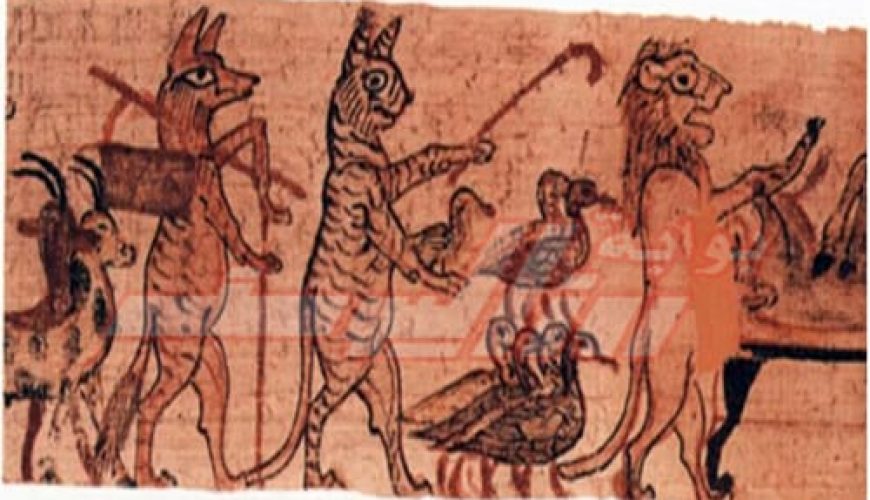Irony and humour in ancient Egypt
Written by the archaeological researcher / Subhi Al-Haddad
The Egyptian people are light-hearted people who love humour, humour and irony even in the worst moments of their lives. This trait has been rooted in us since ancient times. We inherited it from our ancient Egyptian ancestors. On many topics, whether from daily life or myths and some of the humorous and satirical situations in an article published in the Journal of Egypt’s Memory issued by the Bibliotheca Alexandrina, shows that the ancient Egyptians were a light-hearted and entertaining people to the greatest degree and that they were the first to use humour and irony to express their lives.
Because the ancient Egyptians loved humour and laughter, it is said that they believed that the world was created from laughter, so when the Great God wanted to create the world, he fired a strong laugh, so the seven heavens appeared, and another laugh was light and the third created water until we reached the last creation of the soul, and while the written joke was few or even occasional The comic joke, on the contrary, was more common and more powerful and expressive in a society most of which was neither written nor read.
Irony and humour in the tombs of ancient Egypt
Among the most prominent indications that indicate the sense of humour among the Egyptians is the presence of scenes on the walls of the temples and tombs that contain positions full of humour and irony, as the tombs were filled with pictures that express a sense of humour and humour. In their burial places.
But the ancient Egyptian god of laughter and fun.
Due to the Egyptian’s great interest in humour and humour, they dedicated a god of laughter and fun, the god “Bes”, who was depicted in the form of a dwarf with puffy cheeks and a fan-like chin with signs of stinging on his face to provoke terror in the souls of the wicked. He was very popular during the modern state.
The most famous humorous situations from Egyptian social life
Caricatures ridiculing social life at the time also appeared, whether scenes related to agriculture, when drinking excessively, or because of the laziness of the guards, or during work among construction workers, as well as in scenes related to barbering. Among these satirical depictions of social life at the time, Dr Zahi Hawass mentioned them in a previous article, speaking of a drawing on the walls depicting a shepherd who was so thin that he was exaggerated so that his shape was almost close to the skeleton. He portrayed this poor shepherd dragging an exaggeratedly precious cow, and its udder was filled With milk until it almost touched the ground. Of course, the meaning is clear. Despite being grazing such a precious cow that he does not own, this miserable shepherd hardly finds his daily bread.
Another scene expresses the sense of humour of the ancient Egyptians. We can infer it from the mutual dialogue between two sculptors who were photographed sculpting two statues, one of wood and the other of stone, on the walls of one of the tombs of the nobles in Giza, which dates back to the era of the Fifth Dynasty. As for the sculptor who carves the stone, he says:
“I have eaten my hand, and long days have gone by working on this statue, and it seems I will never finish it.”
His colleague sarcastically answers him as he puts the finishing touches on a wooden statue:
Work work, and don’t be stupid, the stone is not like wood
The conflict between cat and mouse is of pharaonic origin
The ancient Egyptians are the first to know the story of the conflict between a cat and a mouse more than 3300 years ago. The folk stories of the ancient Egyptians contained many tales depicting a permanent conflict between a cat and a mouse.
Dr Zahi Hawass also mentioned that one of the funniest caricatures is a scene dating back to the era of the Third Decay, depicting a group of strong young mice. They formed an army that attacked a fortress of impervious cats, throwing arrows at them and destroying the fort with shields and tiles. They even brought a ladder to climb on it and enter the fort under the leadership of their commanding leader. He is a large mouse riding a chariot pulled by two dogs, while the cats inside the fortress are terrified, not knowing how to repel the attack of this army.
And another scene is of a fat mouse wearing expensive clothes and sitting on a sturdy chair while a lean cat is serving him and offers him a drink that the mouse eats through a lollipop so that he does not tire himself by carrying the cup with his hands. An elegant lady as a mouse sits on a chair surrounded by a group of cats serving her. Here we find that the artist wanted to ridicule the social conditions that made the mouse king, even though he was known for weakness and cowardice, and the cat as weak although it is stronger than the mouse.
Those who occupied Egypt throughout the ages could not resist the Egyptian joke. When the Romans occupied Egypt, they prohibited Egyptian lawyers from entering the courts of Alexandria because they were mocking the Roman judges and mocking their weakness in achieving justice, so they used humour and rhyme to defend political prisoners.
irony in literature
The Egyptian writer did not neglect to show his sense of humour and irony in literature, as irony in ancient Egyptian literature contains expressions of criticism, sarcasm and humour, to expose a person or an idea and try to criticize its negatives through the word, as many literary texts written on the papyri included many funny phrases Thus, we find that satirical literature has an extended origin in the ancient Egyptian


Comment (0)